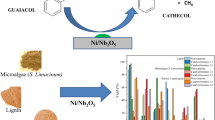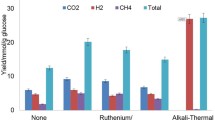Abstract
Pyrolysis is a promising thermochemical process to convert lignocellulosic biomass to renewable biofuel. Much research has been conducted on the catalytic upgrading of either vapors derived from whole biomass scale or on individual model oxygenates. However, not many studies investigated the upgrading and deoxygenation of a mixture of several oxygenates. In this study, we use a combination of techniques to probe the reactions of guaiacol and hydroxyacetaldehyde (HAA) on HZSM-5, their diffusion inside the zeolite catalyst pores, and the extractable products. The techniques we used included several NMR methods, gas chromatography, and thermogravimetric analysis coupled with Fourier transform infrared spectroscopy (TGA-FTIR). In nitrogen at 280 °C with HZSM-5 catalyst, HAA decomposes, cyclizes to form aromatics and phenolic compounds, as well as produces coke. Under the same conditions, guaiacol neither reacts nor forms coke. When the two molecules are present together at 280 °C, their reaction pathways are independent of each other. For HAA at 480 °C, the quantity of aromatics produced is much higher than at 280 °C. At 480 °C guaiacol forms mostly substituted phenolics, BTEX type molecules, and coke. When guaiacol and HAA are mixed together at 480 °C, the amount of coke formed is slightly higher while the aromatics produced in the form of toluene, naphthalene, and their substituted compounds are substantially higher than that can be predicted by simple summation of products in individual cases. After reactions with guaiacol alone or a mixture containing both guaiacol and HAA, the available micropore surface area decreased to zero, indicating plugging of the pores or blocking of pore entrance. However, in both cases the guaiacol and phenolics can be desorbed in an N2 atmosphere at a relatively low temperature range of 100–200 °C. Diffusion measurements indicate that size has a large effect on the pore diffusion coefficients of different oxygen molecules. After coke forms on the catalyst the diffusion coefficients of larger molecules such as guaiacol are affected more significantly than diffusion of small molecules such as water and methanol.






Similar content being viewed by others
References
French R, Czernik S (2010) Catalytic pyrolysis of biomass for biofuels production. Fuel Process Technol 91:25–32
Diebold J, Scahill J (1988) In: Soltes EJ, Milne TA (eds) Biomass to gasoline—upgrading pyrolysis vapors to aromatic gasoline with zeolite catalysts at atmospheric-pressure, Pyrolysis Oils from Biomass-Producing, Analyzing, and Upgrading, Denver, 1988. The American Chemical Society, Denver, pp 264–276
Evans RJ, Milne T (1988) In: Soltes EJ, Milne TA (eds) Molecular-beam, mass-spectrometric studies of wood vapor and model compounds over an HZSM–5 catalyst, pyrolysis oils from biomass-producing, analyzing, and upgrading, Denver, CO, 1988. The American Chemical Society, Denver, CO, pp 311–327
Evans RJ, Milne TA (1987) Molecular characterization of the pyrolysis of biomass. 2. Applications. Energy Fuels 1:311–319
Evans RJ, Milne TA (1987) Molecular characterization of the pyrolysis of biomass. 1. Fundamentals. Energy Fuels 1:123–137
Adjaye JD, Bakhshi NN (1995) Catalytic coversion of a biomass-derived oil to fuels and chemicals. 1. Model-compound studies and reaction pathways. Biomass Bioenerg 8:131–149
Adjaye JD, Bakhshi NN (1995) Production of hydrocarbons by catalytic upgrading of a fast pyrolysis bio-oil. 1. Conversion over various catalysts. Fuel Process Technol 45:161183
Gayubo AG, Aguayo AT, Atutxa A, Aguado R, Bilbao J (2004) Transformation of oxygenate components of biomass pyrolysis oil on a HZSM-5 zeolite. I. Alcohols and phenols. Ind Eng Chem Res 43:2610–2618
Gayubo AG, Aguayo AT, Atutxa A, Aguado R, Olazar M, Bilbao J (2004) Transformation of oxygenate components of biomass pyrolysis oil on a HZSM-5 zeolite. H. Aldehydes, ketones, and acids. Ind Eng Chem Res 43:2619–2626
Gayubo AG, Aguayo AT, Atutxa A, Prieto R, Bilbao J (2004) Deactivation of a HZSM-5 zeolite catalyst in the transformation of the aqueous fraction of biomass pyrolysis oil into hydrocarbons. Energy Fuels 18:1640–1647
Corma A, Huber GW, Sauvanauda L, O’Connor P (2008) Biomass to chemicals: Catalytic conversion of glycerol/water mixtures into acrolein, reaction network. J Catal 257:163–171
Vispute TP, Zhang H, Sanna A, Xiao R, Huber GW (2010) Renewable chemical commodity feedstocks from integrated catalytic processing of pyrolysis oils. Science 330:1222–1227
Centeno A, Laurent E, Delmon B (1995) Influence of the support of CoMo sulfide catalysts and of the addition of potassium and platinum on the catalytic performances for the hydrodeoxygenation of carbonyl, carboxyl, and guaiacol-type molecules. J Catal 154:288–298
Nimmanwudipong T, Runnebaum RC, Block DE, Gates BC (2011) Catalytic conversion of guaiacol catalyzed by platinum supported on alumina: reaction network including hydrodeoxygenation reactions. Energy Fuels 25:3417–3427
Gutierrez A, Kaila RK, Honkela ML, Slioor R, Krause AOI (2009) Hydrodeoxygenation of guaiacol on noble metal catalysts. Catal Today 147:239–246
Graca I, Lopes JM, Ribeiro MF, Ribeiro FR, Cerqueira HS, de Almeida MBB (2011) Catalytic cracking in the presence of guaiacol. Appl Catal B-Environ 101:613–621
Milne TA, Agblevor F, Davis M, Deutch S, Johnson D (1997) A review of the chemical composition of fast pyrolysis oils, in developments in thermal biomass conversion. In Bridgwater AV, Boocock DGB (eds). Blackie Academic and Professional, London, UK, pp 409–424
Mullen CA, Boateng AA (2008) Chemical composition of bio-oils produced by fast pyrolysis of two energy crops. Energy Fuels 22:2104–2109
GrenierLoustalot MF, Larroque S, Grande D, Grenier P, Bedel D (1996) Phenolic resins.2. Influence of catalyst type on reaction mechanisms and kinetics. Polymer 37:1363–1369
Koch H, Pein J (1985) Condensation reactions between phenol, formaldehyde and 5-hydroxymethylfurfural, formed as intermediate in the acid catalyzed dehydration of starchy products. Polym Bull 13:525–532
Ragnar M, Lindgren CT, Nilvebrant NO (2000) pK(a)-values of guaiacyl and syringyl phenols related to lignin. J Wood Chem Technol 20:277–305
Mullen CA, Strahan GD, Boateng AA (2009) Characterization of various fast-pyrolysis bio-oils by NMR spectroscopy. Energy Fuels 23:2707–2718
Wildschut J, Mahfud FH, Venderbosch RH, Heeres HJ (2009) Hydrotreatment of fast pyrolysis oil using heterogeneous noble-metal catalysts. Ind Eng Chem Res 48:10324–10334
Kerssenbaum, R DOSY and Diffusion by NMR; Bruker BioSpin GmbH: Rheinstetten, Germany 2002
Brunauer S, Emmett PH, Teller E (1938) Adsorption of gases in multimolecular layers. J Am Chem Soc 60:309–319
de Boer JH, Linsen BG, van der Plas T, Zondervan GJ (1965) Studies on pore systems in catalysts: VII. Description of the pore dimensions of carbon blacks by the t method. J Catal 4:649–653
Derlacki ZJ, Easteal AJ, Edge AVJ, Woolf LA, Roksandic Z (1985) Diffusion coefficients of methanol and water and the mutual diffusion coefficient in methanol-water solutions at 278 and 298 K. J Phys Chem 89:5318–5322
Caro J, Bulow M, Richter-Mendau J, Karger J, Hunger M, Freude D, Rees LVC (1987) Nuclear magnetic resonance self-diffusion studies of methanol-water mixtures in pentasil-type zeolites. J Chem Soc Faraday Trans 1 Phys Chem Conden Phases 83:1843–1849
Krishna R, van Baten JM (2010) Hydrogen bonding effects in adsorption of water-alcohol mixtures in zeolites and the consequences for the characteristics of the Maxwell–Stefan diffusivities. Langmuir 26:10854–10867
Roque-Malherbe R, Wendelbo R, Mifsud A, Corma A (1995) Diffusion of aromatic hydrocarbons in H-ZSM-5, H-Beta, and H-MCM-22 zeolites. J Phys Chem 99:14064–14071
Kua J, Galloway MM, Millage KD, Avila JE, De Haan DO (2013) Glycolaldehyde monomer and oligomer equilibria in aqueous solution: comparing computational chemistry and NMR data. J Phys Chem A 117:2997–3008
Muller G, Narbeshuber T, Mirth G, Lercher JA (1994) Infrared microscopic study of sorption and diffusion of toluene in ZSM-5. J Phys Chem 98:7436–7439
Graca I, Fernandes A, Lopes JM, Ribeiro MF, Laforge S, Magnoux P, Ribeiro FR (2010) Effect of phenol adsorption on HY zeolite for n-heptane cracking: Comparison with methylcyclohexane. Appl Catal A-Gen 385:178–189
Graca I, Fernandes A, Lopes JM, Ribeiro MF, Laforge S, Magnoux P, Ribeiro FR (2011) Bio-oils and FCC feedstocks co-processing: Impact of phenolic molecules on FCC hydrocarbons transformation over MFI. Fuel 90:467–476
Zhong HE, Wang X (2014) Highly selective catalytic hydrodeoxygenation of guaiacol to cyclohexane over Pt/TiO2 and NiMo/Al2O3 catalysts. Front Chem Sci Eng 8:369–377
Sun J, Karim AM, Zhang H, Kovarik L, Li XS, Hensley AJ, McEwen J-S, Wang Y (2013) Carbon-supported bimetallic Pd–Fe catalysts for vapor-phase hydrodeoxygenation of guaiacol. J Catal 306:47–57
Olcese RN, Bettahar M, Petitjean D, Malaman B, Giovanella F, Dufour A (2012) Gas-phase hydrodeoxygenation of guaiacol over Fe/SiO2 catalyst. Appl Catal B 115–116:63–73
Lu J, Behtash S, Mamun O, Heyden A (2015) Theoretical investigation of the reaction mechanism of the guaiacol hydrogenation over a Pt(111) catalyst. ACS Catal 5:2423–2435
Lu J, Heyden A (2015) Theoretical investigation of the reaction mechanism of the hydrodeoxygenation of guaiacol over a Ru(0 0 0 1) model surface. J Catal 321:39–50
Lee K, Gu GH, Mullen CA, Boateng AA, Vlachos DG (2015) Guaiacol hydrodeoxygenation mechanism on Pt(111): Insights from density functional theory and linear free energy relations. ChemSusChem 8:315–322
Van Speybroeck V, De Wispelaere K, Van der Mynsbrugge J, Vandichel M, Hemelsoet K, Waroquier M (2014) First principle chemical kinetics in zeolites: the methanol-to-olefin process as a case study. Chem Soc Rev 43:7326–7357
Moore HW, Decker OHW (1986) Conjugated ketenes: new aspects of their synthesis and selected utility for the synthesis of phenols, hydroquinones, and quinones. Chem Rev 86:821–830
Tidwell TT (1990) Ketene chemistry: the second golden age. Acc Chem Res 23:273–279
Hamilton GA, Hanifin JW, Friedman JP (1966) The hydroxylation of aromatic compounds by hydrogen peroxide in the presence of catalytic amounts of ferric ion and catechol. Product studies, mechanism, and relation to some enzymic reaction. J Am Chem Soc 88:5269–5272
Bagchi P, Bergmann F, Bannerjee DK (1949) A new synthesis of 9-hydroxy-sym-octahydrophenanthrene. J Am Chem Soc 71:989–992
Wan H, Chaudhari RV, Subramaniam B (2012) Aqueous phase hydrogenation of acetic acid and its promotional effect on p-cresol hydrodeoxygenation. Energy Fuels 27:487–493
Acknowledgments
This work was supported by Laboratory Directed Research and Development Program of the National Renewable Energy Laboratory (NREL) and the Bioenergy Technologies Office (BETO) at the U.S. Department of Energy’s Office of Energy Efficiency and Renewable Energy. NREL is operated by The Alliance for Sustainable Energy, LLC under Contract no. DE-AC36-08-GO28308.
Author information
Authors and Affiliations
Corresponding author
Electronic supplementary material
Below is the link to the electronic supplementary material.
Rights and permissions
About this article
Cite this article
Cheah, S., Starace, A.K., Gjersing, E. et al. Reactions of Mixture of Oxygenates Found in Pyrolysis Vapors: Deoxygenation of Hydroxyacetaldehyde and Guaiacol Catalyzed by HZSM-5 . Top Catal 59, 109–123 (2016). https://doi.org/10.1007/s11244-015-0510-x
Published:
Issue Date:
DOI: https://doi.org/10.1007/s11244-015-0510-x




